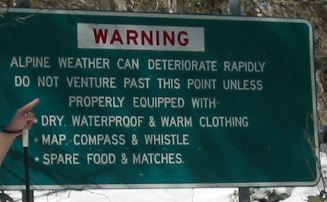Skiing Safety
MNSC trips include a guide as to required skill level (beginner, intermediate, advanced).
Skiers should participate in trips appropriate to their level of fitness, health and skiing experience.
Cross Country Skiing Hazards
- WEATHER
Alpine weather can change rapidly, and weather forecasting is not always accurate. Exposure to freezing temperatures, wind, and rain/sleet/snow (or a combination of these) can be uncomfortable for a skier who is inadequately clothed and protected from the weather. As core body temperature drops, they are at risk of hypothermia, which can have fatal consequences. Skiing above the treeline exposes skiers to the full force of the elements, and requires greater preparedness and awareness of changing weather conditions.
- ULTRAVIOLET RADIATION
UV radiation is extreme at altitude, even on overcast days, and reflects off snow. Severe sunburn or snow blindness can result without protection. Use skin and eye protection – high SPF (sun protection factor) sunscreen and lip balm, sunglasses or goggles, and a hat.

- FALLS & COLLISIONS
While cross country skiing injuries are rare, most result from falls and knee injuries which account for around one quarter of all injuries, with others including the forearm/wrist/hand, thumb and ankle. However, the generally lower speeds when cross country skiing compared to downhill skiing, means that the risk of injury from falls is reduced. This also applies to collisions with other skiers, which are a greater hazard on crowded downhill slopes. Nevertheless, a fall when cross country skiing at speed on a steep trail may involve collision with a tree or rock, and can result in broken bones, concussion or a serious head injury. Take lessons to learn correct skiing technique and how to fall safely, and always ski trails of a grading and at a speed within your ability.
- GETTING LOST
Rarely a hazard on the well sign posted cross country ski trails at established resorts, many of which now show small trail maps with your position marked. However, when venturing outside the patrolled ski trails, or above the treeline, or when visibility is reduced due to falling snow or low cloud, it is quite easy to become "geographically embarrassed". The visual clues of trail markers and indeed trails disappear, and it may become impossible to even retrace your tracks as they disappear under falling snow. That's when carrying a trail map or topographic map comes in handy, particularly if you frequently refer to it to update your location. A compass and the ability to use it will help you locate your position in relation to other features on the terrain, and on the map, and is necessary for establishing the direction to move in when navigating to safety in reduced visibility. A handheld GPS unit is excellent for showing your position coordinates and location on an electronic map, or for translating your coordinates to a paper map. However, if the batteries go flat, a map and compass are essential backup.
- BACKCOUNTRY SKIING HAZARDS
There are particular hazards specific to backcountry skiing outside resort ski patrol boundaries, remote from shelter and assistance, in more challenging mountainous terrain, or when snow camping. These hazards are covered in the appropriate sections (see Menu).
Trip Preparation and Planning
- Always ski in the company of others. Suggested minimum two persons for well marked and patrolled ski trails within resort boundaries, four for back country skiing. In event of injury, one person stays with injured, two go for help.
- Always plan your proposed trip within the capability level of the weakest skier of the group.
- Always let someone outside your group know where you are going, contact numbers for group members, your estimated time of return, and notify them when you are back.
- Where a trailhead has intention forms, fill them in with your group details and estimated time of return.
Equipment
The equipment requirements for a ski tour on patrolled trails should include (in addition to ski equipment and clothing):
- Skin and eye protection – high SPF sunscreen and lip balm, sunglasses or goggles, hat.
- Spare clothing and wind/water proof jacket
- Water bottle or hydration pack (dehydration occurs with activity at altitude)
- Spare high energy food
- Trail map or topographic map
- Mobile phone (Telstra for best coverage) with Emergency+ app installed http://emergencyapp.triplezero.gov.au/
- Contact numbers of other group members, your emergency contact, trip leader, and most importantly contact number for the ski patrol!
.jpg)
On Snow Ski Etiquette & Safety
Knowing how to ski confidently and well, particularly how to handle different types of terrain and snow conditions will enhance your safety. See ski technique page for more details.
